Emily King
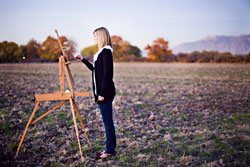
How did you get started with paper cutouts?
I love modern design. When I started having kids, I was disappointed with the lack of modern affordable art for children’s rooms. The paper cutout idea was so appealing to me because it involved this contrast of graphic color blocking qualities but in reality was handmade—you can see the detail in the layers of paper that meet and play off each other, dimensionally and color wise, which really turned it into fine art for me.
While getting my BFA in painting and drawing, I always loved capturing the human figure no matter the medium. This allowed me to do that and mix in a modern color palette in a childlike visual way. Each piece includes design elements of what I love and things that are such a present part of my life: childlike moments, modern unique color stories, the human form simplified yet incredibly descriptive at the same time.
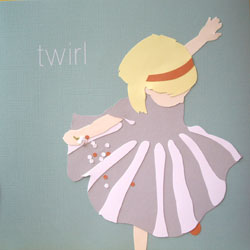
What about painting?
To me, painting is the next level of drawing—getting a good technical foundation in drawing and then being able to creatively describe something in paint. I love paintings that have a duality, where you can see the artist’s technical foundation in drawing but then there are moments of creative abstraction as well. In school we had endless time drawing and painting with models. Now that my studio is at home and I have small children around, having models isn’t really a viable option on a regular basis, so I have taken my painting outdoors. I love to paint plein air, being outside with nature and describing the landscape in paint, the atmosphere, what it feels like right there at that moment. I try to work from photographic references as little as possible but in some cases it’s unavoidable.
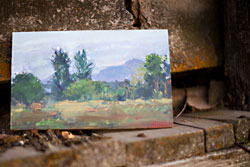
Why art?
My mother is an artist, and from a young age I loved to draw. I was more creatively uninhibited then and I think as a result I won several elementary reflections including a national. Looking back at my childhood creations, they were so fun. Sometimes I am envious of the artist I was then—so into the process—and the result was always secondary. I feel that that is when great art is made.
What’s your usual work process?
Process is definitely the right word. With paper cutouts I will often see an image in my head and begin drawing it out or find an image to reference for a sketch. Sometimes it works and sometimes it doesn’t. Usually the drawings always work, but will it translate to paper in an aesthetically pleasing way? Not always. I am limited with paper—I can’t use light and dark as part of my vocabulary in the way I can with drawing. It becomes more about the silhouette, paper choice, and overall design composition. It’s great to have those aha moments where I cut something down to its most simple form yet it becomes incredibly descriptive at the same time. Those are the moments that keep me creating.
With painting I always start with a tonal underpainting that is more like a drawing, which I use for a reference as I begin to lay in big blocks of color. I like to abstract everything into shapes and avoid looking at the detail. When I feel I have a good handle on the composition, the value and color of each big shape, I then go in for the details. It’s like candy when I get to that point, sweet and fun.
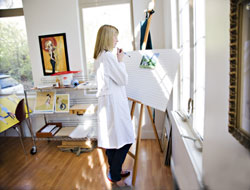
How do you balance your art with raising a family?
Finding the balance is always the hardest thing for me and requires constant attitude adjustments on my part. I often remind myself that life has seasons, and that I am in the season of raising small children. They are small for such a short period of time, and I don’t want to miss those moments. On the other hand, I need to keep one foot in the art world and keep progressing, no matter how small the progress. It’s a tough balance and I don’t always get it right.
I read the book Outliers a while ago. In it, Malcolm Gladwell discusses several studies that point to 10,000 hours as the magical marker to really master a craft. The concept made sense to me but at the same time was daunting. I can’t paint every day all day, so I have to make the time I do have count. Sometimes the most important part is the doing. Right now I limit myself to working only some nights and every Thursday. For now it’s a good balance. If I am playing with my kids, then I try to be in the moment with them, and then likewise with art. It doesn’t always happen but that’s the goal.
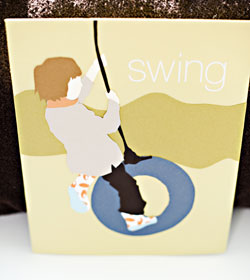
Tell us about making your TWIRL piece.
I wanted to do a piece with more movement then I had previously been doing. At the time, it was one of my daughter Esmae’s favorite Sunday rituals to twirl around in circles and watch the waves of fabric in her dress twirl as well. I took a point of view from above that I think really added to the composition of the piece. After I made the sketch, then I chose my paper. I love trying different color combos and working with amazing handmade Japanese paper, or even letterpress (my other love) patterned paper. Sometimes I’m not sure if it works until I get all the parts assembled. If it doesn’t, it is most likely back to the paper choices, and on occasion I alter the drawing. TWIRL was just one of those pieces that flowed—everything was easy from the get-go and I was really excited about the results.
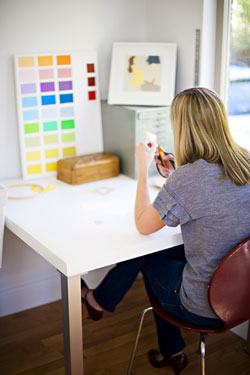
How much of your work is commissioned?
At this point probably half of my work is commissioned from paper cutouts. I love to surprise my buyers with a few important things they have told me about their child and family. It’s an easy interpretation that becomes unique to them. I generally don’t do commissions with paintings—I want the viewer to see the piece and then fall in love with it for a certain reason, with that being their motive to purchase it. I feel if someone tells me what to do in a painting, it hinders my creative process and I don’t get those spontaneous unintended surprises that can make a painting great. Although I must say that it’s really hard for me to say no or turn away work.
What do you do to get better at your craft?
I sketch in my sketchbook when I can—when I am drawing better, I am doing everything better. I also really love to do workshops with some of my old professors when I can. Being able to do art all day for a straight week, or however long the workshop is, is a real luxury for me right now.
I also love a harsh critique—sometimes when you have been looking at something for so long and have seen it evolve in all its forms, it is hard to separate yourself from it. That’s when I call my husband in. He takes one look and usually says something like “the head is too big” and exits, leaving me fuming. But then I look and he is always right. Always. Even without art training, the public is actually a lot better at critiquing art than many may think.
Finally, practicing—lots of practicing combined with critiquing encourages the most progress. If you never recognize your mistakes and don’t move to correct them, you’re running in circles.
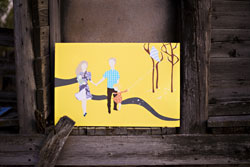
How does the gospel influence your work?
First of all, Minerva Teichert is my absolute hero. I love her. She painted the Mormon story in the most beautiful way and nothing inhibited or stopped her. During a large part of her painting career she was a mother many times over. It’s been said that she was often seen painting huge murals in her living room with a baby on her hip. I love that image. I’m not able to multitask quite like that, but she definitely gives me inspiration about how the gospel hugely influenced her work.
A giclée of Minerva’s “Queen Esther” hangs on one of my walls at home. Sometimes when I glance at the painting I can see Queen Esther’s courage and what great faith she had. It inspires me to strive for greater faith in my life.
I am thinking more about pieces with meaning, maybe subtle gospel truths portrayed in literal or symbolic ways. Something that a mother can have on her walls so when she sees it, it not only gives her visual pleasure but it reminds her to be better and to live better and that she is supported.

How do you see your work helping build the kingdom?
I consistently ask myself this question. One of the most frequently recurring themes in my paper cutouts is children and family. I love exploring the relationships within the family by visually describing everyday moments, realizing that many of those moments are beautiful and begin to bind a family together.
The family is a central component to the gospel. One of my favorite talks is by Elder Uchtdorf, when he addressed the women of the Church on the topic of creation. He said, “The desire to create is one of the deepest yearnings of the human soul…. The more you trust and rely upon the Spirit, the greater your capacity to create.” God is the greatest creator of all, and it’s in everyone’s spirit to create. I feel that so inherently and would love to one day help others discover that in themselves, too, by teaching.
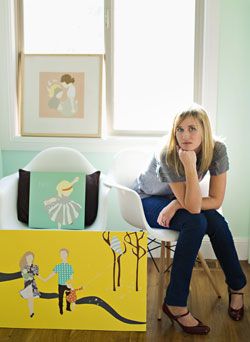
Where do you want to go with your art?
I feel like I am at the beginning of my career. I have lots of ideas and it’s just going to be a matter of weeding through them. Certainly my future holds lots of failed paintings, but hopefully it holds lots of successes, too. Creating pieces that will uplift people is important to me. We already have so much heartache in this life and I think art that makes a statement is important. I am not sure exactly what my statement will be, but I do know that it will be for good. ❧
